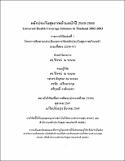บทคัดย่อ
การศึกษาครั้งนี้มีวัตถุประสงค์เพื่อติดตามประเมินผลการจัดหลักประกันสุขภาพถ้วนหน้าในระหว่างปี 2544-2547 ซึ่งเป็นการสรุปการดำเนินงานของโครงการที่เกี่ยวข้องกับหลักประกันสุขภาพของภาครัฐที่สำคัญ 4 โครงการคือ โครงการสวัสดิการข้าราชการและพนักงานรัฐวิสาหกิจ โครงการประกันสังคมและกองทุนเงินทดแทน กองทุนทดแทนผู้ประสบภัยจากรถ และโครงการ 30 บาทรักษาทุกโรค จนสิ้นปีงบประมาณ 2546 เป็นอย่างน้อย ผลการศึกษาพบว่าแต่ละโครงการก็มีปัญหาแตกต่างกันไปคือ โครงการสวัสดิการข้าราชการด้านการพยาบาลครอบคลุมข้าราชการและครอบครัว (พ่อ แม่ และบุตรที่ยังไม่บรรลุนิติภาวะอีกไม่เกิน 3 คน) โดยให้สิทธิ์ข้าราชการหรือสถานพยาบาลเบิกจ่ายค่ารักษาพยาบาลจากกรมบัญชีกลางโดยไม่มีการกำหนดเพดาน ในช่วงระยะเวลาเพียง 13 ปี (2531-2544) ค่าใช้จ่ายของโครงการนี้เพิ่มขึ้นเป็น 6 เท่าตัว โครงการประกันสังคมและกองทุนเงินทดแทน มีปัญหาในการจ่ายเงินในกรณีที่มีการส่งต่อผู้ป่วยจากโรงพยาบาลเอกชนไปยังโรงพยาบาลระดับตติยภูมิ ซึ่งในบางกรณีกลายมาเป็นอุปสรรคในการส่งต่อผู้ป่วยที่จำเป็นต้องได้รับการรักษาที่มีความซับซ้อน โครงการกองทุนทดแทนผู้ประสบภัยจากรถ ประสบปัญหาในเรื่องสิทธิ์ซ้ำซ้อนกับหลักประกันอื่นๆ ทำให้ผู้ประสบภัยมักไม่อยากใช้สิทธิ์นี้ในกรณีที่มีความยุ่งยาก เช่น ต้องไปแจ้งความ และในกรณีที่ผู้ประสบภัยมีผลประโยชน์ร่วมกับผู้ก่อความเสียหาย โครงการ 30 บาทรักษาทุกโรค เนื่องจากเป็นโครงการที่รัฐบาลต้องการอำนวยความสะดวกให้แก่ประชาชนให้มากที่สุด จึงเก็บค่ารักษาพยาบาลในอัตราเดียวคือ 30 บาท ปรากฏว่ามีผู้มาใช้บริการมาก ทำให้โรงพยาบาลส่วนใหญ่มีรายได้ที่ไม่เพียงพอต่อการจ้างแพทย์มาทำการรักษา ทำให้รัฐบาลจำเป็นต้องปรับสัดส่วนของเงินเดือนใหม่โดยแยกเงินเดือนออกจากงบเหมาจ่ายรายหัวให้ลดลง สรุปผลการศึกษาได้ว่าหลักประกันสุขภาพถ้วนหน้าปี 2545-2546 ยังมีปัญหาอยู่บ้างพอสมควร ในเรื่องของการให้บริการที่ยังไม่ได้ประสิทธิภาพเป็นที่น่าพอใจของประชาชน ทางรัฐบาลจึงได้เสนอวิธีแก้ไขปัญหาดังกล่าวขึ้น คือ การยกระดับสิทธิประโยชน์ของแต่ละโครงการให้เท่ากันหมดทุกโครงการ แต่ในด้านความเสมอภาคนั้น มีความจำเป็นต้องปรับเปลี่ยนกลไกการจ่ายเงินของแต่ละโครงการให้มีความใกล้เคียงกัน เพื่อลดปัญหาแรงจูงใจของสถานพยาบาลที่จะให้บริการในลักษณะสองหรือหลายมาตรฐาน
บทคัดย่อ
This report is part of the research project “Monitoring and Evaluating Universal Health Care Coverage in Thailand” The report summarizes major changes and adjustments in the three major schemes in the Fiscal Years 2002-2003, namely, (1) Civil Servant Medical Benefit Scheme (CSMBS), (2) Social Security Scheme (SSS) and Worker Compensation Fund, and (3) 30 Baht Scheme. The study also look into the Car-accident Compensation Scheme, which could be considered a supplemental scheme. CSMBS provides health care benefits to government officials and their dependent (parents and up to three children) The scheme covers roughly 4 million people and the cost is 26 billion baht for 2003. The payment mechanism is retrospective fee-for-service. During the past 13 years (1988-2001), the program cost has increased six-fold, averaging 15 percent per annum. SSS is primarily a compulsory scheme that covers about 8.3 million private employees in the formal sector. The scheme imposes mandatory social security taxes from the employer, employees, and the government, to the social security fund, and provides health care benefits to the insured as one of its seven benefits. Health care cost for work-related accidents and injuries are paid for by the Worker Compensation Fund, which is also administered by the Social Security Office and collects premiums solely from the employers. Those insured by the SSS can choose a hospital listed as the main-contractor. The payment mechanism of the scheme to the health care providers is mainly prospective per capitation. (The Worker Compensation Fund pay the hospitals on fee-for-service, but with a ceiling per accident or injury). So hospital-based data suggest that the number of outpatient visits increased substantially in 2002 and continued to rise in 2003. The number of admissions and inpatient day also increased in both years. The utilization rate of outpatient for those who eligible for the 30 Baht scheme-except for those who were originally from the HWPLID—is lower than those in SSS and CSMBS (except in the Northern Region where those in the 30 Baht Scheme have the highest utilization rate for outpatients). As for inpatients, those in the 30 Baht Scheme had an admission rate higher than those in SSS, but clearly lower than those in CSMBS who had the highest rate of admission and the highest length of stay. Those in the 30 Baht Scheme had the highest referral rate, but part of their increased visits and referrals could be caused by the regulation that a patient has to seek care from the designated hospital first. Since the three major health insurance schemes are unlikely to merge in the near future, there have been concerns on equity and overlapping coverage. Part of the overlapping coverage is due to incentive problem : multiple cardholders still benefit from having more than one card as there has been no one dominant scheme under which the benefit package is better than other schemes in every aspect. One plausible measure to solve the incentive problem is to elevate certain benefits under the CSMBS that are still below than those of the SSS and the 30 Baht scheme and also elevate certain benefit of the SSS that are still below that of the 30 Baht scheme. In addition, reform on payment mechanisms is needed to curtail health provider’s incentive in having double/multiple standards in taking care of patients under different schemes.


